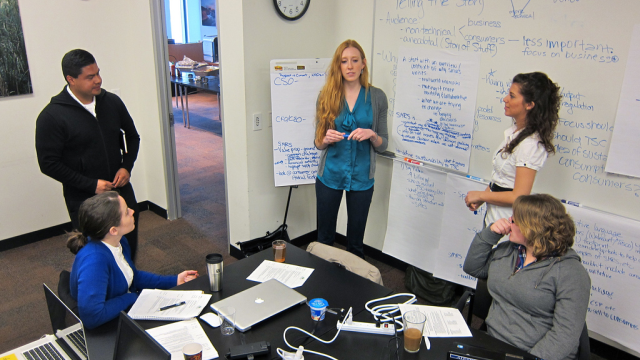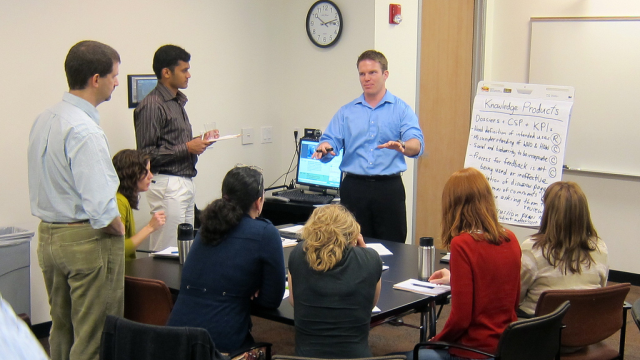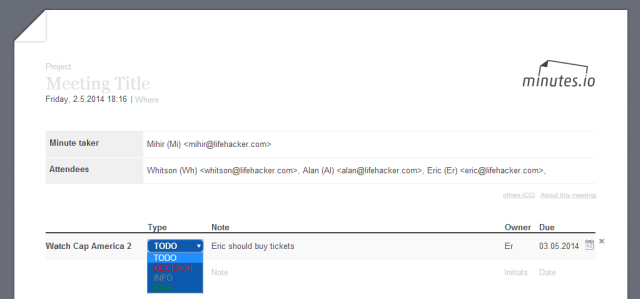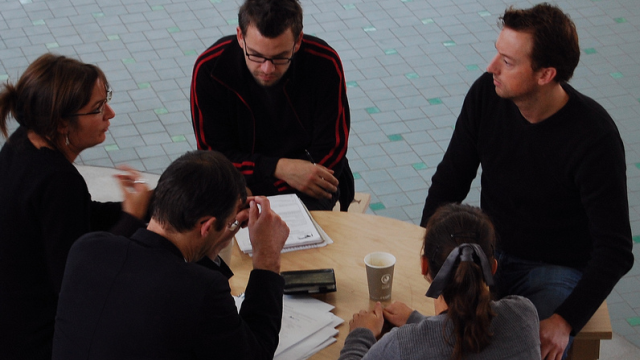A poorly-managed meeting can suck away time, energy and money. Here’s what you should and shouldn’t do when meeting in a group at work, whether you are leading the meeting or not.
Pictures: Rawpixel (Shutterstock), Simon Blackley, Kevin DooleyKevin Dooley, geralt, bluegum, wagg66, jwmpap
Before The Meeting

There are three W’s to address before the office meeting ever takes place: when, who and why. The fourth W, “where”, is obviously in your office.
Why
Why are you meeting? If you don’t ask that question, you will get nothing done at the meeting itself.
Crew founder Mikael Cho notes that a meeting shouldn’t be the place where you brainstorm ideas; you need to tell the attendees to do that in advance and show up with a clear list for discussion. Similarly, the meeting organiser should send required reading at least three days in advance, says blogger Scott Berkun, and make it concise enough so that everyone has actually read it before they show up.
Who
Too often, a meeting requires no contribution from a certain individual, but he or she is asked to be there just so they are kept in the loop. Just send them the meeting’s minutes and stop wasting everyone’s time.
Qwest COO Teresa Taylor asks three questions at the start of a meeting, which actually should be applied before the invitations are issued:
Do we all know why we’re here? Are we making decisions? Are you going to ask me for something at the end?
If you are the person holding the meeting, imagine that anyone you invite is asking you these questions. Your answers will reveal whether you need them at the meeting or not. And remember, no invitations to keep them in the loop.
If you have an invitation to a meeting, ask those questions to the person inviting you. Again, their answer will let you know whether you should be a part of it or not. Don’t be afraid to decline to attend a meeting if you don’t think it is going to be more productive than the work you would have gotten done otherwise.
When

You have the who, you have the why, now it’s a matter of choosing timing that works for everyone. Coordinating with multiple people is difficult, but not impossible. Meeting scheduling service When Is Good analysed 100,000 responses to 34,000 events and found that Tuesdays at 3pm is the most agreeable meeting time for most people. Of course, you don’t need to stick to that and you can use any meeting scheduler like TimeToMeet to pick a commonly agreeable time.
Apart from the starting time, the total length of the meeting is important too. People will give you their time based on how much you ask for. We usually think in half-hour or one-hour time blocks, but there is no logical reason to do that. In fact, it’s best to schedule meetings for brevity, says marketing consultant Chris Brogan:
Schedule for Brevity: One of my old bosses, Dan Carney, used to tell me to schedule meetings to be no more than 10 minutes. As project manager, he had me do all the running around outside of the meeting so that I could have individual conversations with the stakeholders in the pending meeting, and so that I could hear them at length outside the time frame of the meeting. This worked magical wonders, for three reasons:
- People knew the meetings would be brief so they showed up on time.
- People knew I’d done my homework, so they just nodded their heads at the right parts.
- People gave their best efforts to be on the “good” side of the updates at these meetings, because being “behind” or “delayed” or in an otherwise negative status really stands out in a 10 minute meeting.
There’s another trick for scheduling meetings that businessman Lin Wu uses to make sure they are as short as possible and everyone is attentive: have standing meetings at the end of the day.
I’d schedule that meeting for around 5 p.m., when everyone was tired and ready to go home, and I wouldn’t allow anyone to sit down. I never had a meeting last more than an hour. Most lasted 20 to 30 minutes. It kept everyone focused and effective.
During The Meeting

Once the prep and setting for the meeting has been laid out, you need to concentrate on the actual meeting itself.
Designate a Parent
Meetings can go off-track easily, and before you know it, you have wasted a whole lot of time and energy discussing something that wasn’t scheduled. Productivity guru Merlin Mann says that each meeting needs a designated “parent” who steers the meeting responsibly.
One thing to note is that this person does not need to be the meeting organiser or leader. Often, the leader or organiser is the person who questions are going to be asked to and is going to be actively involved in the discussion, so keeping things on track is one responsibility too many. Instead, pick the person who everyone in the room thinks is fair, and get him or her to ensure the meeting doesn’t go off on tangents.
Ensure People Are On Time
And for all your scheduling, you need to ensure people are on time. Time Management Ninja suggests a good trick for that: set consequences for when you show up:
One company had a rule that the last to arrive was responsible for taking meeting notes. Another required that last person to clean up the meeting room when all was said and done. On the flip side, reward the early birds with refreshments, perhaps, or first dibs on new projects.
The meeting parent, known for responsibility and fairness, can also help in choosing these consequences.
Get Everyone On The Same Page
Once everyone has showed up, it’s good to know where they all stand in terms of their understanding of the subject at hand. The presenter can best put the point across when the room’s mood is clear. To gauge that without embarrassing anyone, Fast Company recommends making a “climate quadrant” which everyone fills out anonymously.
Use a white board or easel pad to display a four-quadrant chart with these labels: stormy, calm, clear, foggy. Before the meeting starts, have each participant add checkmarks to quadrants that reflect their understanding and outlook about the topic. Leave the room or have your back to the chart during this process. If checkmarks cluster in stormy and/or foggy quadrants, you’ll need to add time for questions, explanations, and maybe pep talks. But if checkmarks cluster in calm and clear quadrants, surge ahead with new business.
A whiteboard and asking everyone to leave the room might not be logistically feasible, in which case, pass around chits with the quadrant and ask everyone to tick one of the boxes, and hand them all back to the meeting parent or presenter.
Manage Gadget Time

Everyone brings laptops or tablets and mobile phones to the meeting. Invariably, these are distractions. At this point, that pretty much can’t be helped. What you can control is how you allow people to manage their gadgets during a meeting.
Karen Cleveland of Manners Are Sexy recommends “topless meetings”, where everyone is mandatorily required to stash away their devices, with nothing on the tabletop. But that isn’t going to solve your innate need to take a break from the face time and let your mind wander to other matters, often the notifications on your phone. To resolve this, business professor Christine Pearson advises scheduling short breaks in your meeting where attendees are encourage to check their gadgets, but are held under the “topless meeting” guidelines once break time is over.
Remove The Words “I Like”
Yahoo CEO Marissa Mayer believes amplifying data is more important than personal choices in a meeting, says Businessweek, because it removes the notion that a decision is being made because of any partiality or favoritism.
Mayer discourages using the phrase “I like” in design meetings, such as “I like the way the screen looks.” Instead, she encourages such comments as “The experimentation on the site shows that his design performed 10% better.”
Take Minutes and Notes

Make sure there are pads and pens at a meeting and encourage people to take notes. Not only do they help clarify thoughts, but they are also useful in your post-meeting discussion.
You also need one person in the meeting taking the minutes, which was the suggested consequence of coming in last. Minutes.io is a super-simple app for creating these minutes and then you can share them easily too. Of course, this means that one minute-taker will be exempt to the no-gadget rule. But don’t skip on the minutes — it helps to have a record of what was discussed and a concise summary that can be mailed out to people who need to be kept in the loop, but don’t have to attend the meeting.
After The Meeting

Once the meeting is done, it’s important to know what everyone’s takeaway from it was and what the future plan should be.
What The Group Should Do
In his seven imperatives to keep meetings on track, Robert C. Pozen, senior lecturer at Harvard Business School, says there are three questions that should be asked at the end of each meeting:
- What do we see as the next steps?
- Who should take responsibility for them?
- And what should the timeframe be?
If you aren’t taking minutes in the meeting, the answers to these questions, by each participant, should be recorded and sent out. Not only does it make sure everyone is on the same page, it also provides accountability since no one can say they weren’t sure or didn’t remember what happened.
Once you have that laid out, do a final review through an “action points summary”, advises 99U.
At the end of a meeting, go around and review the action steps each person has captured.The exercise takes less than 30 seconds per person, and it almost always reveals a few action steps that were missed.The exercise also breeds a sense of accountability.If you state YOUR action steps in front of YOUR colleagues, then YOU are likely to follow through.
What You Should Do

Apart from the meeting’s learnings as a group, it is important to include your own learnings for your personal growth. You could set time aside to review your notes periodically, but Medium writer Robyn Scott shares a lesson she learnt from an unnamed CEO about how he learnt from each meeting. And all it takes is 30 seconds right after the meeting:
Immediately after every lecture, meeting, or any significant experience, take 30 seconds — no more, no less — to write down the most important points. If you always do just this, said his grandfather, and even if you only do this, with no other revision, you will be OK.

Comments